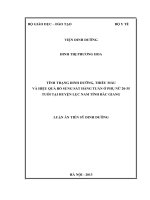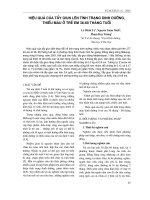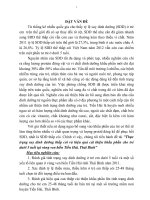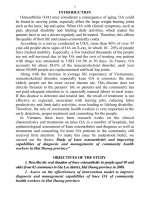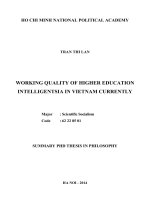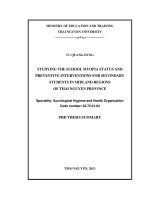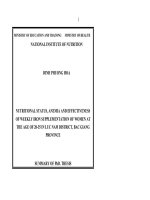tình trạng dinh dưỡng, thiếu máu và hiệu quả bổ sung sắt hàng tuần ở phụ nữ 20-35 tuổi tại huyện lục nam tỉnh bắc giang bản tóm tắt tiếng anh
Bạn đang xem bản rút gọn của tài liệu. Xem và tải ngay bản đầy đủ của tài liệu tại đây (1.27 MB, 45 trang )
1
MINISTRY OF EDUCATION AND TRAINING MINISTRY OF HEALTH
NATIONAL INSTITUTE OF NUTRITION
DINH PHUONG HOA
NUTRITIONAL STATUS, ANEMIA AND EFFECTIVENESS
OF WEEKLY IRON SUPPLEMENTATION OF WOMEN AT
THE AGE OF 20-35 IN LUC NAM DISTRICT, BAC GIANG
PROVINCE
SUMMARY OF PhD. THESIS
2
Specification: Nutrition
Code: 62.72.03.03
HA NOI, 2013
THIS WORK IS COMPLETED AT
THE NATIONAL INSTITUTE OF NUTRITION
Scientific Advisors:
1. Prof. Le Thi Hop, MD, PhD
2. PhD. Pham Thi Thuý Hoa, MD, PhD
3
Reviewer 1:
Reviewer 2
Reviewer 3:
This thesis shall be defended in front of the Doctoral Thesis Committee at The Institute Level in the
National Institute of Nutrition
At ,
The thesis can be found at:
- National Library
- National Institute of Nutrition Library
4
LIST OF ABBREVIATIONS
BMI Body Mass Index
CED Chronic Energy Deficiency
CTR Control group
FAO Food Agriculture Organization
Hb Hemoglobin
IDA Iron Deficiency Anemia
IFA Iron Folic Acid
INACG International Nutritional Anemia Consultative Group
SD Standard Deviation
T0 The start of intervention
T16 Intervention at 16 weeks
T28 Intervention at 28 weeks
UNICEF United Nations International Children’s Emergency
Fund
WHO World Health Organization
5
PHS Public health significances
EI Effectiveness index
6
INTRODUCTION
Undernutrition and anemia are the main causes affecting the health status of millions of people around
the world.
In developing countries, the prevalence of anemia in women in general is 42% and in pregnant women
is 52%. Iron Deficiency Anemia is the most common nutritional anemia in almost every countries around the
world.
Like other developing countries, anemia in Vietnamese mothers and children is identified as an
important public health significance. According to the report of the Institute of Nutrition in 2009-2010, the
prevalence of anemia in women of reproductive age is 28.8% and in pregnant women is 36.5%, while this
prevelance in the northern and central mountains is up to 60%. The main cause of anemia in women Vietnam
is also because of the iron deficiency, which accounts for 22% to 86.3% in rural and mountainous areas.
Iron / folic acid supplementation is considered to be one of the key solutions to solve the problem of
iron deficiency anemia. Vietnam currently applied treatment regimens for anemia by supplementing iron
daily for children and pregnant women. However, the effectiveness of using iron tablets according to daily
7
regimen method is limited by side effects on the gastrointestinal tract, the difficulties of propaganda and
maintaining compliances with medication as directed.
Weekly iron supplementation is one of the effective solutions similar to daily iron supplementation.
Moreover, weekly iron supplementation reduces significantly the rate of side effects and also helps save the
iron tablet, so that we can expand for more objects, especially for women who are not pregnant.
Based on the above reasons, we conduct testing consecutive weekly iron supplementation and
intermittent weekly iron supplementation for women aged 20-35 in Luc Nam, which is a mountainous
district located in the North-East of Bac Giang province.
Objectives
1. To evaluate the nutritional status, anemia, worm infection rate and dietary intakes among women
aged 20-35 in six communes in Luc Nam district, Bac Giang province.
2. To compare the effectiveness of consecutive weekly iron supplementation and intermittent
weekly iron supplementation to anemia status of women aged 20-35.
8
NEW CONTRIBUTIONS OF THE THESIS
Provide more data for the Chronic Energy Deficiency (CED), the prevalence of anemia, worm infection
and dietary intakes of women aged 20-35 in six communes of Luc Nam district, Bac Giang province.
Suggest new weekly iron supplementation regimen. This regimen is highly valuable in selecting the
solutions for anemia prevention for reproductive aged women and can be applied in a larger scale.
Suggest for further researches on intermittent weekly iron supplementation trial at 16th, 18th and 20
th
week for reproductive aged women, especially those at the areas that have high CED, anemia and worm
infection rate.
STRUCTURE OF THE THESIS
The thesis consists of 114 pages in which the main content is presented within 105 pages, including:
Introduction (3 pages) Overview (30 pages); Subjects and Methods (21 pages); Results (34 pages)
Discussion (22 pages); Conclusions and Recommendations (4pages). There are 36 tables, 12 figures and 148
references documents, in which 36 documents are in Vietnamese and 112 documents are in English.
CHAPTER 1. LITERATURE REVIEW
9
1.1. NUTRITIONAL STATUS OF WOMEN IN REPRODUCTIVE AGE
1.1.1. Worldwide
According to the statistics of Safe the Children in 2012, there is 10%-20% of women in sub-Saharan
Africa and 25%-35% of women in South Asia who suffer from severe chronic energy deficiency.
The data in 2008 shows that there are 1.5 billion people overweight (BMI≥ 25), in which nearly 200
million women are obese (≥30). In developing countries such as ThaiLan, Trung Quoc, Indonesia and
Malaysia, the overweight rates are 37,4%, 25,4%, 25,0% and 46,3%, respectively and obese rates are 12,2%,
6,7%, 6,9% and 17,6%, respectively.
1.1.2. In VietNam
Resuls of the nutrition survey in the period of 2009-2010 show that CED rate in women over 19 is
18.5%. The rate of overweight and obesity of people at the age of 20 and older is 5.6%, which accounts for
4.9% in male and 6.3% in female.
Nutritional anemia due to iron deficiency
1.1.1. Worldwide: According to WHO’s statistics on 192 countries from 1993 to 2005, there were 56.4
million pregnant women who were anemic, accounting for 41.8%, of which the prevalence of anemia is
10
highest in Africa (57,1%), followed by Southeast Asia (48,2%). The prevalence of anemia in European and
America was lower (25,1% and 24,1%).
There are approximately 468.4 million pregnant women having anemia worldwide, accounting for
30.2%. Africa is still the continent with the highest rate of anemia (47.5%), South East Asia has a lower rate
of anemia (45.7%). Europe and America anemia rates are nearly the lowest (19% and 17.8%).
1.2.2.2. Anemia of reproductive aged women in Vietnam
According to the latest figures, anemia among Vietnamese women at childbearing age is 28.8%, which
has a moderate public health significance.
CHAPTER 2. STUDYING OBJECT AND METHODOLOGY
2.1. Location and time of research:
2.1.1. Location:
The study was conducted in 6 poor communes: Bac Lung, Cam Ly, Bao Dai, Dong Hung, Kham Lang
and Truong Giang, Luc Nam district, Bac Giang province.
2.1.2. Time:
Screening Survey: June 2008
11
Intervention study: 6/2008 to 1/2009
2.2. Studying object:
Women aged 20-35 (the age group with the highest childbirth rate)
Excluding criteria: Women aged 20-35 who are breastfeeding, pregnant, suffering from blood diseases,
chronic diseases, birth defects and refuse to take part in.
2.3. Studying methodology
2.3.1. Research design: The research has 2 stages
Stage 1: Cross-sessional study to evaluate nutritional status, worm infection and dieatary intakes.
Stage 2: Community intervention experiment with control group to evaluate the effectiveness of weekly
iron supplementation with each.
2.3.2. Sample size and sampling method
2.3.2.1. Phase 1: Cross-sessional descriptive study
Apply the formula to the research of the nutritional status survey, anemia rate and worm infection rate:
12
Nutritional status investigation: p: prevalence of chronic energy deprivation is (36.8%). Estimated object
size is 373.
Anemia rate investigation: p: estimated anemia rate is 28.2%. Estimated object size to take blood is 329.
Worm infection rate investigation: p: estimated worm infection rate is 29%. Estimated object size to test
stool is 341.
Dietary intakes investigation: Use the formula:
δ: standard deviation of the average calories ingested (taken as 400 kcal)., e: acceptable deviation
(appointed to be 100 Kcal). Sample size of dieatary intakes investigation would be 210.
Sampling Method: Sampling process comprises several stages:
Stage 1 (select district): intentionally selected Luc Nam district.
Stage 2 (select commune): intentionally selected Bac Lung, Bao Dai, Dong Hung, Truong Giang and
Kham Lang.
13
Stage 3 (select studying object): randomly selected the system through the list of women aged 20-35 of
chosen communes.
2.3.2.2. Phase 2: Community- based controlled intervention study
The intervention was implemented in Dong Hung, Truong Giang and Bac Lung communes, Luc Nam
district.
+ Objects: Women aged 20-35 from cross-sectional study.
+ Excluding criteria: Women who suffer from severe anemia (Hb <70 g/L), were pregnant at the
beginning as well as during study time and refuse to participate in the study.
+ Hb mean deviation investigation: use the following formula:
+ Minimum sample size to detect statistical significance differences in reliability, Zα = 1,96(α =0.05)
và Zβ = 0.84 (β =0.20); Zα+ Zβ = 2,8; µ
2
- µ
1
: expected Hb mean deviation before and after the
intervention (approximate: 4.5 g/L); δ: standard deviation before and after the intervention (approximate:
8g / L).
14
+ The sample size n = 50. To ensure a sufficient number of after interventing sample, included 10%
lost of data. We have n = 55 objects per group. The total sample needed to investigate is (55 x 3) = 165
objects.
+ Ferritin mean change investigation: investigate every object who was tested Hb.
+ Nutritional status investigation: investigate every object who was taken blood in phase 2.
+ Dietary intakes investigation: using the formula which was used in cross-sessional study. The
sample size for each group is 30. Sample size for 3 groups is (3 x 30 = 90).
+ Therefore, the total participated objects is 55 per group x 3 groups = 165 objects.
Sampling and grouping: Select intentionally 3 communes having a high anemia rate to intervene.
Choose randomly 1 commune to be the control group – no iron supplementation. 1 commune:
consecutive weekly iron/acid folic supplementation (group CT1); 1 commune: intermittent weekly iron/acid
folic supplementation (group CT2)
Sampling the dietary intakes: choose randomly system from 165 objects, select 90 samples to ask for
dietary intakes.
Supplement dose: iron/acid folic Fumafer B9 Corbière, coated tablet which contains Fe (II) fumarat:
200mg equals to 66mg elemental iron and 1mg acid folic in each tablet.
15
Supplement 16 iron/acid folic in 16 consecutive weeks with group CT1. Supplemet 16 iron/acid folic in
28 intermitternt weeks with group CT2.
2.4. CONDUCTING STUDY
Before conducting study, PhD student had a meeting with local health centre, presented purpose,
methodology, research plan and list out criteria for selecting communes and objects.
2.4.1. Collecting data methodology
2.4.1.1. Interview: collect necessary information related to health and nutrional status of objects.
2.4.1.2. Investigate nutritional status:
Weight: Use SECA electronic scale with an accuracy of 0.01 kg.
Height: Use UNICEF wooden ruler.
2.4.1.3. Dietary intakes asking: 24 hours recall
2.4.1.4. Laboratory tests:
16
Hemoglobin laboratory test: By Cyanmethemoglobin method, using Hemoglobinometer.
Ferritin laboratory test: By enzyme-linked immune asay method (ELISA method)
Stool laboratory test: By Kato method (WHO)
2.4.1.5. Clinic examination: detect acute, chronic cases, pregnant cases and physical defecting,…
2.4.2. Variables, research index and assessment criteria:
Nutritional status: categorizing based on BMI
BMI < 18.5: CED
BMI: 18.5 – 24.9: Normal
BMI ≥ 25: overweight – obesity
Anemia status: According to WHO’s classification
Normal: Hb ≥ 12g/dL
Anemia: Hb < 12g/dL
17
Iron status: Ferritin serum < 30µg/L: low iron stores
Iron deficiency anemia: simultaneous 2 criteria: Hb concentration: Hb < 12g/dL and Ferritin serum
concentration: Ferritin serum < 15 µg/L
Dietary intakes assessment: Base on the energy intakes, assess the responses to the recommended dietary
allowances for Vietnamese.
Economics, social and cultural condition: Base on educational status, physiological state, job, religion,
nation.
Worm infection status: assesss based on the number of worm egg/1g stool
Intervention effect: assess based on effective index of intervention.
Rough effectiveness index :Using the following formula
H: effectiveness (%)
A: rate at the beginning at T0
18
B: rate after intervening at T16, T28
Real effectiveness index : Using the following formula
IE = H1 - H2
IE: intervention effect
H1: effective index of intervention group
H2: effective index of control group
2.5. Study supervision
Keep track iron tablet taking through monthly note-taking system of medical staff, individual’s tablet taking
record, then selecting randomly and interviewing.
2.6. Data analyzing and processing
Use EPI data 3.1, SPSS 15.0 (SPSS Inc, Chicago. IL, USA) program to entry and analyze statistics.
Dietary intakes statistics is processed by ACCESS software.
19
2.7. Error limit method
Keep the investigators who weigh, measure height, ask dietary intakes from the beginning to the end to avoid
error by the implementers. Accurate weighing, measuring and asking technique.
Comply with processes of sample taking, storage, preventing contamination of chemicals from the outside.
Measurements were analyzed using updatedly standard method.
Entry double data and cross-examine when combine data.
2.8. Study ethics
The research was conducted since Science Council and Ethics Council of Nutrition Institute approved.
Blood collection devices were ensured safe and used only 1 time.
Objects suffering from severe anemia (Hb<70 g/L) in screening survey were given iron tablets according to
treatment regimens before excluding from the study. The anemic objects, right after the end of the study
were informed and treated with iron tablets.
20
CHAPTER 3. RESEARCH RESULTS
3.1. NUTRITIONAL STATUS AND WORM INFECTION
3.1. Results of the screening survey of nutritional status, anemia, worm infection and dietary intakes of women
aged 20-35.
The survey’s result on 650 women aged 20-35 showed that 94.9% of women working in the fields.
Most of them were literate (99.7%), the majority (64.0%) of women had education level at secondary school.
About half of the surveyed households were in poverty (50.9%).
21
3.1.1. The nutritional status of the PN 20-35 age 6 communes
Figure 3.1. CED prevalence (BMI<18,5) of women aged 20-35
Among 650 objects surveyed, there were 254 women suffering from CED, accounting for 39.1% of
total studying objects.
3.1.2. Anemia status among women aged 20-35 at 6 communes
Table 3. 1. Mean Hb concentration of women by age groups
Age groups N Mean Hb (g/dl) p
20-24 125 13,1 ± 1,3
>0,05
25-29 236 13,0 ± 1,2
30-35 289 12,9 ± 1,2
22
Total 650 13,0 ± 1,2
Mean Hb concentration of women aged 20-35 is 13.0 g/dl. Hb concentration was similar between two
age groups 20-24 and 25-29 (13.1 and 13.0 g / dl), age group 30-35 has a lower Hb level (12.9 g / dl).
However, there are no differences in Hb mean among 3 age groups (p> 0.05) (ANOVA test).
Table 3. 2. Anemia prevalence (Hb<12g/dL) of women by age groups
Age groups N Aneamia (Hb<12g/dL) p
n (%)
20-24 125 14 11,2
>0.05
25-29 236 36 15,3
30-35 289 55 19,0
Total 650 105 16,2
The general anemia rate at 6 communes is 16.2%, in which the lowest is in age group 20-24 (11.2%),
the highest in age group 30-35 (19.0%). The difference has no statistical significance (p>0.05; χ
2
test).
Table 3. 3. Categorize anemia status by age groups
Age groups N Mild anemia Moderate anemia p
n (%) N (%)
23
20-24 125 9 7,3 5 4,0
>0,0525-29 236 32 13.6 4 1,7
30-35 289 49 17,0 6 2,1
Total 650 90 13,9 15 2,3
The mild anemia rate of objects is 13.9%, moderate anemia rate is 2.3% and there is no severe anemia
case. The difference in anemia status among age groups has no statistical significance (p>0.05; χ
2
test).
3.1.3. Worm infection status of women aged 20-35 at 6 communes
Table 3.4. Worm infection status of women aged 20-35
Worm infection rate n Prevalence (%)
Mono-infection
- Ascaris infection 105 19,4
- Trichuris infection
28 5,2
- Hookworm infection 77 14,2
Multi-infection
- One type of worm infection 9 1,7
24
- Two types of worm infection
87 16,1
- Three types of worm infection
9 1,7
Total 541 100,0
3.1.4. Dietary intakes of women aged 20-35 at 6 research communes
Table 3. 5. Dietary nutrition value of women compared to recommended dietary allowances
(person/day)
Nutrients
Mean ± SD Demand % response to
demand*
Energy (Kcal) 1954,2 ± 360,7 2300 85,0
Total protein (g) 64,5 ± 17,8 12-14% 94,3
Animal protein (g) 19,4 ± 13,9 30-35% 85,9
Total lipid (g) 29,9 ± 16,2 20% 68,9
Plant lipid (g) 9,9 ± 8,1 30% 110,4
Glucid (g) 356,9 ± 72,1 66% 73,0
Iron (mg) 13,0 ± 4,3 39,2 33,2
Vitamin C (mg) 46,5 ± 30,5 70 66,4
25
3.2. Result of intervention study
3.2.1. Effectiveness on improving nutritional status and anemia of consecutive weekly iron/acid folic
supplementation
Figure 3.2. Changes in CED status before and after 16 weeks intervention
CED rate at group CT1 decreases 8.7% (from 39.7% to 31.0%) while increases 1.9% at control group
(from 39,6% to 41,5%) (fig 3.2). Nonetheless, the difference between 2 groups has no statistical meaning
(p>0,05).
Table 3. 6. Mean Hb concentration changes after 16 weeks intervening
